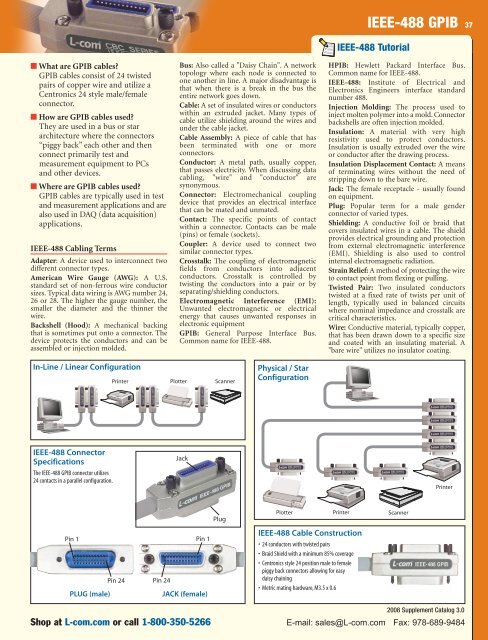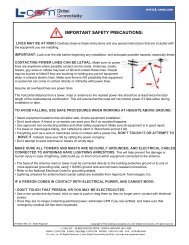pages - 14mb
pages - 14mb
pages - 14mb
You also want an ePaper? Increase the reach of your titles
YUMPU automatically turns print PDFs into web optimized ePapers that Google loves.
■ What are GPIB cables?<br />
GPIB cables consist of 24 twisted<br />
pairs of copper wire and utilize a<br />
Centronics 24 style male/female<br />
connector.<br />
■ How are GPIB cables used?<br />
They are used in a bus or star<br />
architecture where the connectors<br />
“piggy back” each other and then<br />
connect primarily test and<br />
measurement equipment to PCs<br />
and other devices.<br />
■ Where are GPIB cables used?<br />
GPIB cables are typically used in test<br />
and measurement applications and are<br />
also used in DAQ (data acquisition)<br />
applications.<br />
IEEE-488 Cabling Terms<br />
Adapter: A device used to interconnect two<br />
different connector types.<br />
American Wire Gauge (AWG): A U.S.<br />
standard set of non-ferrous wire conductor<br />
sizes. Typical data wiring is AWG number 24,<br />
26 or 28. The higher the gauge number, the<br />
smaller the diameter and the thinner the<br />
wire.<br />
Backshell (Hood): A mechanical backing<br />
that is sometimes put onto a connector. The<br />
device protects the conductors and can be<br />
assembled or injection molded.<br />
Bus: Also called a "Daisy Chain". A network<br />
topology where each node is connected to<br />
one another in line. A major disadvantage is<br />
that when there is a break in the bus the<br />
entire network goes down.<br />
Cable: A set of insulated wires or conductors<br />
within an extruded jacket. Many types of<br />
cable utilize shielding around the wires and<br />
under the cable jacket.<br />
Cable Assembly: A piece of cable that has<br />
been terminated with one or more<br />
connectors.<br />
Conductor: A metal path, usually copper,<br />
that passes electricity. When discussing data<br />
cabling, "wire" and "conductor" are<br />
synonymous.<br />
Connector: Electromechanical coupling<br />
device that provides an electrical interface<br />
that can be mated and unmated.<br />
Contact: The specific points of contact<br />
within a connector. Contacts can be male<br />
(pins) or female (sockets).<br />
Coupler: A device used to connect two<br />
similar connector types.<br />
Crosstalk: The coupling of electromagnetic<br />
fields from conductors into adjacent<br />
conductors. Crosstalk is controlled by<br />
twisting the conductors into a pair or by<br />
separating/shielding conductors.<br />
Electromagnetic Interference (EMI):<br />
Unwanted electromagnetic or electrical<br />
energy that causes unwanted responses in<br />
electronic equipment<br />
GPIB: General Purpose Interface Bus.<br />
Common name for IEEE-488.<br />
IEEE-488 GPIB 37<br />
IEEE-488 Tutorial<br />
HPIB: Hewlett Packard Interface Bus.<br />
Common name for IEEE-488.<br />
IEEE-488: Institute of Electrical and<br />
Electronics Engineers interface standard<br />
number 488.<br />
Injection Molding: The process used to<br />
inject molten polymer into a mold. Connector<br />
backshells are often injection molded.<br />
Insulation: A material with very high<br />
resistivity used to protect conductors.<br />
Insulation is usually extruded over the wire<br />
or conductor after the drawing process.<br />
Insulation Displacement Contact: A means<br />
of terminating wires without the need of<br />
stripping down to the bare wire.<br />
Jack: The female receptacle - usually found<br />
on equipment.<br />
Plug: Popular term for a male gender<br />
connector of varied types.<br />
Shielding: A conductive foil or braid that<br />
covers insulated wires in a cable. The shield<br />
provides electrical grounding and protection<br />
from external electromagnetic interference<br />
(EMI). Shielding is also used to control<br />
internal electromagnetic radiation.<br />
Strain Relief: A method of protecting the wire<br />
to contact point from flexing or pulling.<br />
Twisted Pair: Two insulated conductors<br />
twisted at a fixed rate of twists per unit of<br />
length, typically used in balanced circuits<br />
where nominal impedance and crosstalk are<br />
critical characteristics.<br />
Wire: Conductive material, typically copper,<br />
that has been drawn down to a specific size<br />
and coated with an insulating material. A<br />
"bare wire" utilizes no insulator coating.<br />
In-Line / Linear Configuration<br />
Printer Plotter Scanner<br />
Physical / Star<br />
Configuration<br />
IEEE-488 Connector<br />
Specifications<br />
The IEEE-488 GPIB connector utilizes<br />
24 contacts in a parallel configuration.<br />
Jack<br />
Printer<br />
Plug<br />
Pin 1<br />
Pin 1<br />
Pin 24 Pin 24<br />
PLUG (male)<br />
JACK (female)<br />
Plotter<br />
Printer<br />
IEEE-488 Cable Construction<br />
• 24 conductors with twisted pairs<br />
• Braid Shield with a minimum 85% coverage<br />
• Centronics style 24 position male to female<br />
piggy back connectors allowing for easy<br />
daisy chaining<br />
• Metric mating hardware, M3.5 x 0.6<br />
Scanner<br />
2008 Supplement Catalog 3.0<br />
Shop at L-com.com or call 1-800-350-5266 E-mail: sales@L-com.com Fax: 978-689-9484



